A litany of ‘safe and effective’
Published : Monday 29 April 2024
There are many examples of modern marvels that subsequently turn out to be detrimental to human health and the trend continues ...

Throughout history, there have been many examples of ‘modern-day marvels’ of science and technology that were heralded as the next best thing, often with celebrated health benefits. However, in reality, they have later been found to be detrimental to health and the environment. This blog explores some of the more notable examples and leaves us with the question: Where might we be going wrong today?
Lobotomy
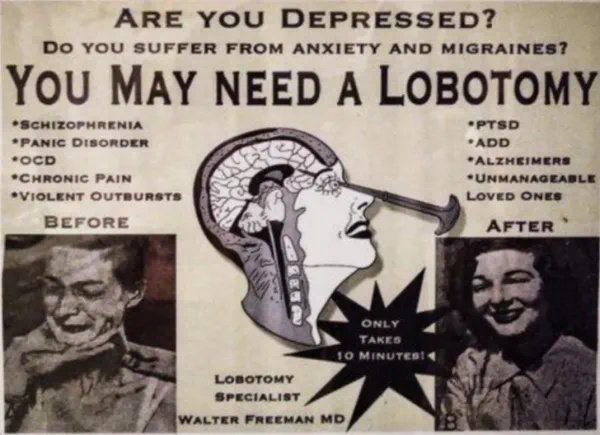
(Click for full resolution)
Lobotomy, developed in the 1930s, is a surgical procedure that involves removing or damaging the brain’s prefrontal cortex as a treatment for various mental illnesses. Initially hailed as a breakthrough in psychiatry, lobotomy gained widespread attention and acceptance, even leading to its inventor being awarded the Nobel Prize. The procedure was performed on thousands of patients worldwide, including those with conditions ranging from schizophrenia to depression, often without informed consent or proper consideration of the potential risks and long-term consequences, raising significant ethical and safety concerns. As the adverse effects of lobotomy became more apparent, including personality changes, cognitive impairment, and in some cases, fatalities, its popularity declined. Its legacy remains controversial, serving as a cautionary tale about the dangers of medical interventions without proper scientific scrutiny and ethical oversight.
Radium
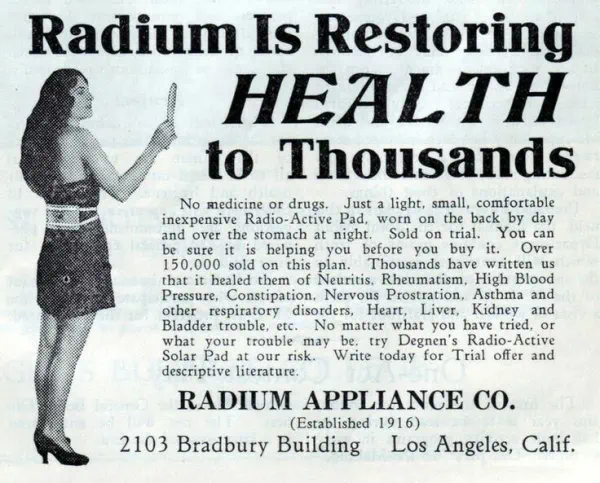
(Click for full resolution)
Radium, a highly radioactive element discovered in 1898, was hailed as a miraculous substance, quickly gaining popularity in various consumer products during the early 20th century, such as cosmetics and health tonics. As the adverse health effects of radiation exposure became better understood, concerns about radium’s safety began to emerge. Despite attempts to conceal risks and refute scientific evidence, public awareness campaigns and legal battles ultimately led to stricter regulations and the phasing out of radium-based products. Today, radium’s use is heavily restricted, primarily confined to specialized industrial and medical applications under tightly controlled conditions..
Asbestos
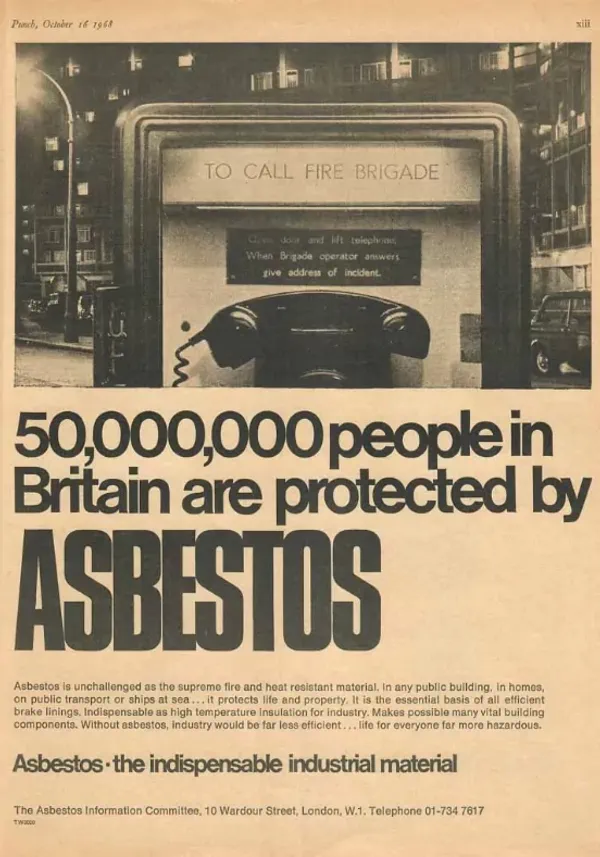
(Click for full resolution)
Asbestos gained immense popularity throughout the 20th century, permeating various industries and products due to its affordability and unique properties. By the mid-20th century, alarming health concerns began to emerge, particularly its link to respiratory diseases. Despite these early warnings, many manufacturers and asbestos companies engaged in extensive cover-ups and lobbying efforts to downplay the risks and continue profiting from its use. It wasn’t until the late 20th century, after numerous lawsuits and regulatory interventions, that the dangers of asbestos became widely acknowledged. Today, its use is heavily restricted or banned in many countries, although its legacy continues to pose challenges in terms of environmental remediation and public health.
Thalidomide (Distaval)
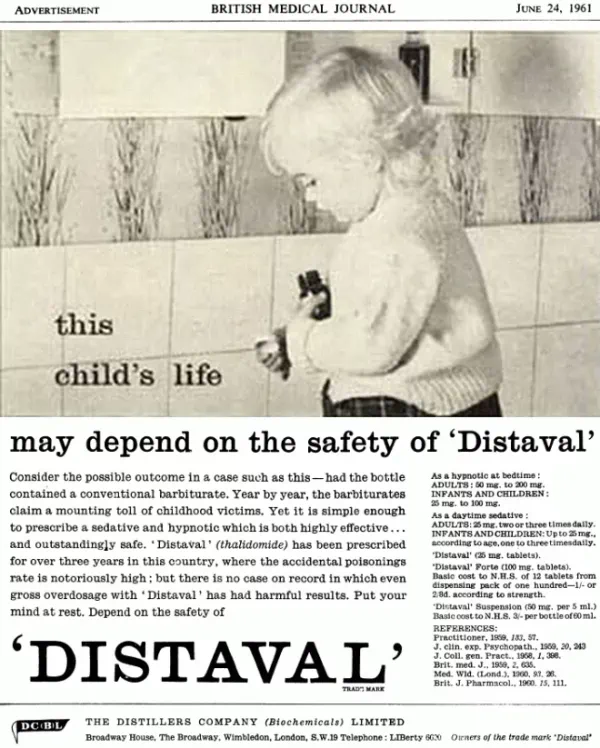
(Click for full resolution)
Developed in the late 1950s, Thalidomide was initially introduced as a sedative and anti-nausea medication for pregnant women, gaining widespread popularity across Europe and other parts of the world. It wasn’t until the early 1960s that the devastating consequences of Thalidomide came to light, with reports linking it to severe birth defects in infants born to mothers who had taken the drug during pregnancy. Despite efforts by the manufacturer to suppress negative findings and downplay the risks, mounting evidence and advocacy from affected families eventually forced authorities to take decisive action. Thalidomide was swiftly withdrawn from the market, and stringent measures, including stricter drug testing protocols and enhanced pharmacovigilance systems, were implemented.
Lead paint
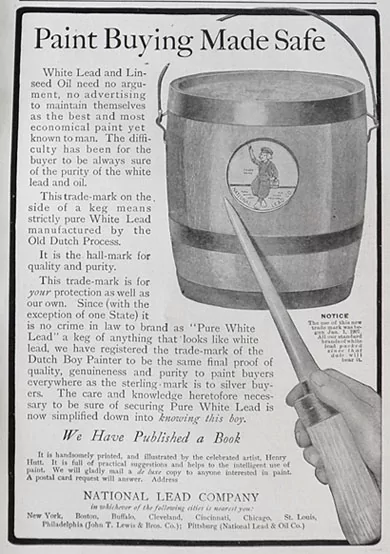
Lead, a natural heavy metal, has been utilized by humans for thousands of years owing to its unique properties. In the late 19th and early 20th centuries, lead became ubiquitous in various consumer products, notably in paint and plumbing materials, as well as in gasoline. Lead-based paint gained widespread popularity due to its durability and vibrant colors. However, the dangers of lead exposure emerged in the early 20th century, with scientists and public health officials recognizing its toxic effects, particularly on children. Despite vigorous defense by the lead industry and lobbying against regulation, over time, measures such as the banning of lead-based paint and the replacement of lead pipes in water systems have been implemented to mitigate exposure risks. Nonetheless, the consequences of past lead use continue to impact communities worldwide.
Smoking
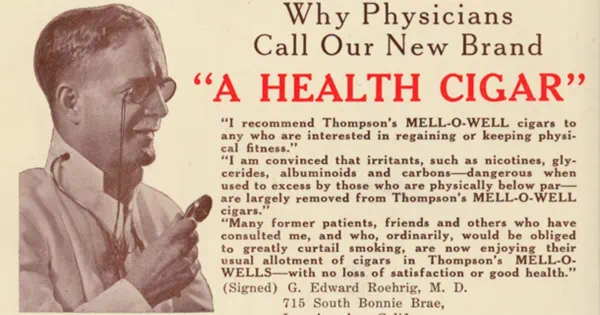
(Click for full resolution)
Smoking tobacco traces its origins back to indigenous cultures in the Americas, but it wasn’t until the late 19th and early 20th centuries that it became popularized globally, particularly with the advent of mass production and marketing of cigarettes. As cigarette prevalence increased, so did awareness of its health risks. In the mid-20th century, scientific research conclusively linked smoking to lung cancer, heart disease, and numerous other health problems. Tobacco companies fought hard to suppress or discredit the evidence, but towards the latter end of the 20th century, tobacco control measures, including advertising restrictions, warning labels on cigarette packs, and indoor smoking bans, began to take effect. Despite these efforts, the tobacco industry continued to resist regulation and promote its products, especially in emerging markets. In the 21st century, smoking rates have declined in many countries due to increased awareness of the health risks, implementation of tobacco control policies, and shifting social norms. However, smoking remains a leading cause of preventable death globally.
Vioxx (Rofecoxib)

(Click for full resolution)
Vioxx, the brand name for the drug rofecoxib, was introduced by the pharmaceutical company Merck & Co. in 1999 as a nonsteroidal anti-inflammatory drug (NSAID) primarily used to relieve arthriti symptoms. It was marketed as a safer alternative to traditional NSAIDs and became one of Merck’s best-selling drugs. Concerns about Vioxx’s safety emerged in the early 2000s when studies revealed an increased risk of cardiovascular events, including heart attacks and strokes, among long-term users. Despite these findings, Merck continued to aggressively promote Vioxx and downplay the risks, leading to widespread use of the drug. In 2004, Merck withdrew Vioxx after a large-scale clinical trial confirmed the elevated cardiovascular risks associated with the drug. The withdrawal of Vioxx sparked significant controversy and raised questions about pharmaceutical industry practices and subsequent investigations revealed that Merck had withheld data and downplayed the risks of Vioxx.
Teflon

(Click for full resolution)
Teflon, a brand name for polytetrafluoroethylene (PTFE), was developed in 1938 by DuPont. Initially utilized in military and industrial applications for its nonstick and heat-resistant properties, Teflon gained widespread popularity in consumer products during the mid-20th century, particularly in nonstick cookware. However, concerns about the safety of Teflon emerged in the late 20th century as studies revealed health risks associated with the release of perfluorooctanoic acid (PFOA), a chemical used in the production of Teflon. PFOA was found to persist in the environment and bioaccumulate in humans, raising concerns about its potential carcinogenic and toxic effects. DuPont downplayed these risks and failed to disclose health hazards associated with Teflon. In 2006, DuPont reached a settlement to phase out the use of PFOA by 2015 and transition to alternative chemicals. Despite this, PFOAs remain prevalent in our daily lives, and new ‘PFOA-free’ formulations raise new questions about safety and long-term health impacts.
Today’s outlook
This is just a snapshot of examples, as there are many others such as CFS, Mercury, DDT, PCB, to name a few. Throughout history, there have been many marvels of science and discovery heralded for their properties, only to be found detrimental later on, and the trend continues, failing to learn the lessons of the past. Today, we continue to be surrounded by chemicals, some subtly slipped into our day-to-day lives, while others are celebrated as modern marvels. Hexane, PFOA, BPA, Fluoride, Glyphosate, to name a few, exist in everyday items such as floss, tap water, processed foods, carpet, receipts, paint, cosmetics, and the list goes on, not to mention medical products and interventions with questionable efficacy and safety profiles.
The common thread is that each generation seems to believe we have somehow reached a level of scientific or technological superiority, yet as it relates to health, the ‘arrogance of public health’ is well-documented. Furthermore, the consolidation of markets and centralization of power and money appear to have compromised the very systems put in place to protect public health. For example, 75% of the UK MHRA (Medical Health Regulation Authority) funding comes from parties it regulates or parties closely associated with them. A similar story exists with the US FDA.
It seems the situation hasn’t improved; it may even be worse. One thing is for certain: there are plenty of concerning safety signals, and for the most part, there is silence across the board.
References
- Radithor and the Era of Mild Radium Therapy https://jamanetwork.com/journals/jama/article-abstract/382766
- Lessons to be learnt from the history of lobotomy https://pubmed.ncbi.nlm.nih.gov/36511739/
- The worldwide pandemic of asbestos-related diseases https://pubmed.ncbi.nlm.nih.gov/23297667/
- The thalidomide disaster, lessons from the past https://pubmed.ncbi.nlm.nih.gov/23138926/
- Lead-based paint remains a major public health concern: A critical review of global production, trade, use, exposure, health risk, and implications https://pubmed.ncbi.nlm.nih.gov/30179767/
- History of tobacco and health https://pubmed.ncbi.nlm.nih.gov/14528877/
- What have we learnt from Vioxx? https://www.ncbi.nlm.nih.gov/pmc/articles/PMC1779871/
- PTFE-coated non-stick cookware and toxicity concerns: a perspective? https://pubmed.ncbi.nlm.nih.gov/28913736/
- Knowns and unknowns on burden of disease due to chemicals: a systematic review? https://pubmed.ncbi.nlm.nih.gov/21255392/
- The arrogance of preventive medicine https://www.ncbi.nlm.nih.gov/pmc/articles/PMC117852/
- The illusion of evidence based medicine https://www.bmj.com/content/376/bmj.o702.long
- From FDA to MHRA: are drug regulators for hire? https://www.bmj.com/content/377/bmj.o1538
Dan's Blog
Information Technology, programming, health, fitness and photography enthusiast.
- Not a writer.
- All views are my own.
- Offence is optional.
- Do your own research.